Directions (1–5) : Read the following table carefully and answer the questions given below.
Percentage increase in population of 6 villages from 2002 to 2003 and from 2003 to 2004
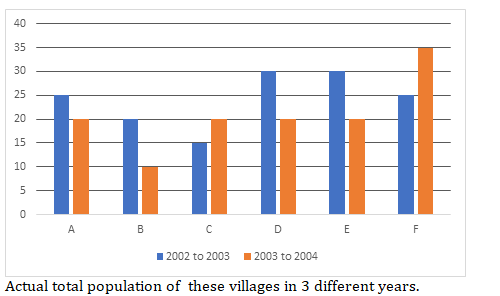
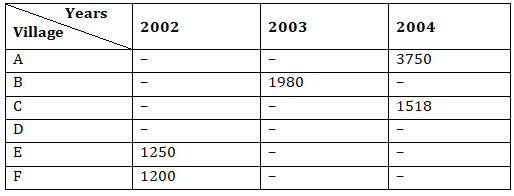
Q1. What is the ratio of total population of village E in 2004 to village A in 2002?
(a) 41:50
(b) 37:45
(c) 48:31
(d) 44:53
(e) None of these
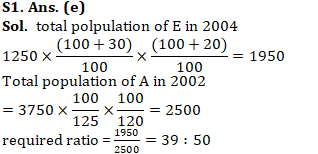
Q2. Total population of village A in 2002 is what percent more than total population of village C in 2002? (round off to 2 decimal Places)
(a) 129.27%
(b) 127.27%
(c) 135%
(d) 123.37%
(e) 133.33%

Q3. If ratio of total population of village C and D in 2002 is 22:27, then what will be total population of village D in 2004?
(a) 1350
(b) 2108
(c) 1250
(d) 2106
(e) 2316

Q4. The total population of F in 2002 is what percent of the total population of same village in 2004? (round off to 2 decimal places)
(a) 53.26
(b) 59.38
(c) 49.38
(d) 57.38
(e) 59.26

Q5. Total population in 2002 of all villages together is approximately what percent less than the total population in 2004 of all villages together?
(a) 33
(b) 39
(c) 37
(d) Can’t be determined
(e) None of these
![]()
Directions (6-10): Compare the value of 2 quantities given in the question and give answer
Q6.
Quantity I — cost price (in Rs) of an article having marked price Rs. 400, which when sold at 20% discount still make a gain of ![]()
Quantity II — cost price (in Rs) of an article which is sold at 14% profit and if cost price and selling price are decreased by Rs. 117, the profit would be 23%.
(a) if quantity I > quantity II
(b) if quantity I < quantity II
(c) if quantity I ≥ quantity II
(d) if quantity I ≤ quantity II
(e) if quantity I = quantity II or no relation can be established

Q7.
Quantity I — the sum of money (in Rs) for which the difference between SI and CI obtained on it in 2 years at 6% per annum is Rs. 43.2.
Quantity II — Rs. 12850
(a) if quantity I > quantity II
(b) if quantity I < quantity II
(c) if quantity I ≥ quantity II
(d) if quantity I ≤ quantity II
(e) if quantity I = quantity II or no relation can be established
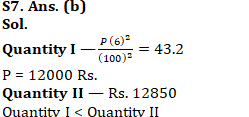
Q8.
Quantity I — average income (in Rs) of the whole group of 75 people, if average income of the men in the group is Rs. 4200 and that of women is Rs. 4000. (total men : total women = 8 : 7)
Quantity II — the average income (in Rs) of 20 people, which decreases by Rs. 150 if a person with income of Rs. 1000 joins them.
(a) if quantity I > quantity II
(b) if quantity I < quantity II
(c) if quantity I ≥ quantity II
(d) if quantity I ≤ quantity II
(e) if quantity I = quantity II or no relation can be established
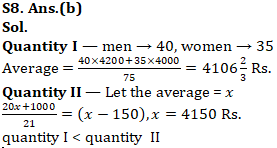
Q9.
Quantity I — The distance (in km) of school from Aman’s house, if he reaches school 5 minutes late when walking at 4 km/hr but 10 minutes earlier than scheduled time when walking at 5 km/hr.
Quantity II — 5 km
(a) if quantity I > quantity II
(b) if quantity I < quantity II
(c) if quantity I ≥ quantity II
(d) if quantity I ≤ quantity II
(e) if quantity I = quantity II or no relation can be established

Q10.
Quantity I — Product of 2 numbers, whose sum is 17 and sum of the squares of 2 no. is 145.
Quantity II — Sum of 2 numbers, whose product is 1400 and difference between them is 5.
(a) if quantity I > quantity II
(b) if quantity I < quantity II
(c) if quantity I ≥ quantity II
(d) if quantity I ≤ quantity II
(e) if quantity I = quantity II or no relation can be established

Directions (11-15) :In each of these questions, two equations are given. You have to solve these equations and find out the values of x and y and-
![]()
(a) If x > y
(b) If x ≥ y
(c) If x < y
(d) If x ≤ y
(e) If x = y or relationship cannot be established
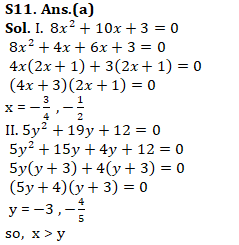
![]()
(a) If x > y
(b) If x ≥ y
(c) If x < y
(d) If x ≤ y
(e) If x = y or relationship cannot be established

![]()
(a) If x > y
(b) If x ≥ y
(c) If x < y
(d) If x ≤ y
(e) If x = y or relationship cannot be established
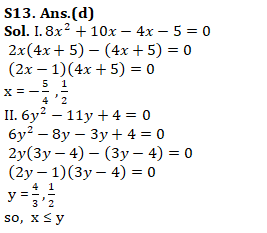
![]()
(a) If x > y
(b) If x ≥ y
(c) If x < y
(d) If x ≤ y
(e) If x = y or relationship cannot be established

![]()
(a) If x > y
(b) If x ≥ y
(c) If x < y
(d) If x ≤ y
(e) If x = y or relationship cannot be established
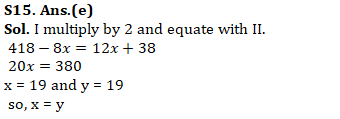
For 200+ most important arithmetic questions
- Quantitative Aptitude Study Notes for Bank Exams
- 100 MCQs Data Interpretation | Download Free PDF’s of DI
- Quantitative Aptitude Questions for all Competitive Exams
All the Best BA’ians for IBPS RRB PO/Clerk Main

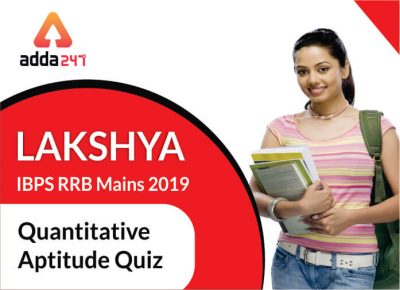



 GA Capsule for SBI Clerk Mains 2025, Dow...
GA Capsule for SBI Clerk Mains 2025, Dow...
 The Hindu Review October 2022: Download ...
The Hindu Review October 2022: Download ...
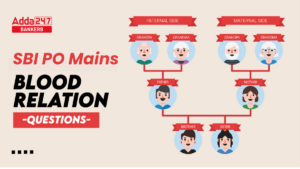 Important Blood Relation Questions for S...
Important Blood Relation Questions for S...





